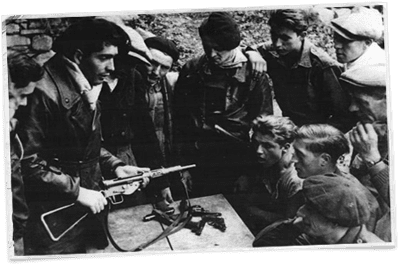The following article on the French Resistance is an excerpt from Barrett Tillman’ D-Day Encyclopedia. It is available for order now from Amazon and Barnes & Noble.
The French Resistance was never a homogeneous organization. Through much of the four years of German occupation the maquis was composed of comprised groups and individuals often following their own agendas. Consequently, there was little unity in the resistance movement during the early phase. In fact, French communists supported the Nazi invasion in 1940, acting as a ‘‘fifth column,’’ owing to Hitler’s nonaggression pact with Stalin. When Germany invaded Russia the following year, allegiances changed and the communists became a significant factor in the resistance.
Eventually, however, necessity dictated a more formal structure. The Conseil National de la Resistance (CNR) was led by Georges Bidault, working in concert with the government in exile. Anticipating a need for greater unity and eventual restoration of French independence, in May 1943 the CNR formally recognized Charles de Gaulle as head of state. De Gaulle had already dispatched Jean Moulin to organize a nationwide resistance organization in early 1942. Though Moulin was betrayed and killed in 1943, his maquisards worked diligently to make the CNR a reality. When the Allies landed in 1944, a provisional government was prepared to take the reins of leadership.
When the French Forces of the Interior (FFI) was officially organized in February 1944, the armed resistance movement already had years of experience. The major resistance groups were the Gaullists, the communists, and the army’s own organization. While the communists generally remained separate, the various components of the FFI provided significant assistance to the Allies. The resistance was particularly effective in returning downed Allied fliers to Britain, often at risk to French lives. Probably the greatest contribution was current intelligence reports on all aspects of German activities in France. However, resistance groups also engaged in sabotage; during the month preceding D-Day they stopped nearly all German rail traffic in Brittany for more than a week. Though often infiltrated by the Gestapo, which neutralized or destroyed some cells, at its peak the FFI numbered about three hundred thousand men and women drawn from the nation’s forty-two million citizens.
Shortly before D-Day the Germans had some indication of impending resistance activity when Oberst (Col.) Helmuth Meyer, the German Fifteenth Army’s intelligence officer, heard the preliminary message from the British Broadcasting Corporation. The BBC broadcast the warning order to the French Resistance, from Paul Verlaine’s ‘‘Chanson d’Automne’’— ‘‘The long sobs of the violins of autumn.’’ The next segment would indicate invasion within twenty-four to forty-eight hours—‘‘wounds my heart with a monotonous languor.’’
This article is part of our larger selection of posts about the Normandy Invasion. To learn more, click here for our comprehensive guide to D-Day.
This article on the French Resistance is from the book D-Day Encyclopedia, © 2014 by Barrett Tillman. Please use this data for any reference citations. To order this book, please visit its online sales page at Amazon or Barnes & Noble.
You can also buy the book by clicking on the buttons to the left.
Cite This Article
"French Resistance: The Thorn of Vichy France" History on the Net© 2000-2024, Salem Media.
April 17, 2024 <https://www.historyonthenet.com/french-resistance>
More Citation Information.
